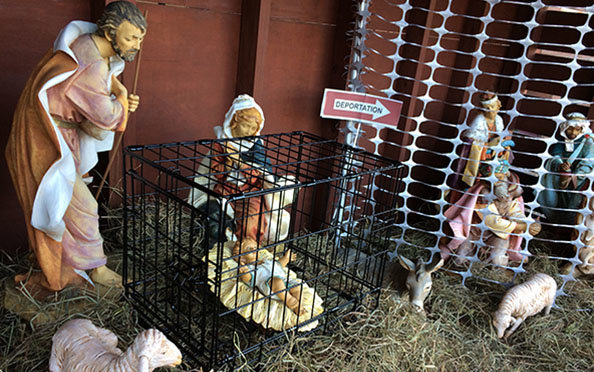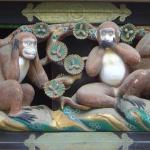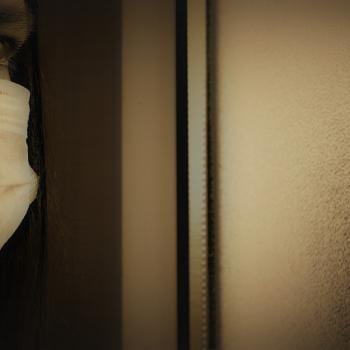A Catholic church in Massachusetts has become the focus of national debate, and considerable hand-wringing from the Right, on account of its unusual nativity display.
According to a report in the Huffington Post, St. Susanna’s Parish in Denham “is mixing faith and politics in its nativity display this year ― placing a baby Jesus figurine in a cage to provoke conversations about America’s immigration policies.”
In the display, Baby Jesus lies in his traditional manger – but inside a black wire cage, a kind often used for containing animals. A plastic barrier fence separates the Wise Men from the rest of the scene, and a banner overhead reads “Peace on Earth?”
Right-wing media personality Sean Hannity has bewailed this as “Christmas under siege,” while other commenters have called the display “blasphemous.” Parishioners are even leaving St. Susanna’s because of this.
Reverend Steve Josoma of St. Susanna’s has said that the inappropriate and jarring nature of this nativity scene is the point:
“People think children in diapers getting tear-gassed is OK, but this [Nativity scene] is totally sacrilegious?” Josoma said in response to the criticism. “All we’re trying to do is put the two together.”
“What you do to somebody else is what you do to Christ,” he said, referring to a Bible passage that claims those who welcome strangers are in effect welcoming Christ himself. “You can’t separate the two.”
Josoma is simply presenting fundamental Gospel morality.
And yes, fundamental Gospel morality has not always been comfortable: look at how many people, in the New Testament accounts, turned away from Jesus because of his hard sayings.
We’re used to coming to church during the Advent and Christmas seasons in search of hope and joy. We want to feel settled, cozy even. Our repetition of family traditions helps us to cultivate this sense of belonging, of being at home, of the customary and comfortable. We light candles, keep the house warm, string lights over trees, play music.
But what if we’re doing it wrong?
Advent, after all, is not about being settled. It’s about a tension of waiting, and not just waiting for a happy surprise – waiting for a deliverer, for justice, for renewal. What is promised with the coming of the deliverer is peace, yes – but it’s a peace that is only possible through radical disruption of customs and norms, of governments and powers, even of the earth itself. It’s a comfort that is far from comfortable.
The old tradition of telling ghost stories as part of the Advent and Christmas season serves to enhance our sense of the unheimlich, the uncanny, of being on the verge of something undiscovered and strange. The deliverer who comes is not the one you expected. The place where the unseen world blurs into the world of flesh and blood is not where you expected a god to arrive.
Lighting candles isn’t just a way to make a room warm and inviting. It’s also a way to summon spirits.
The Christmas story is one that can be both comforting and unsettling.
On one hand, the presence of the Divine is manifest in such an ordinary human way, within a woman’s body. On the other hand, there’s nothing comfortable about pregnancy or giving birth. On one hand, the stable is warm and inviting, the animals innocent. On the other hand the stable is a place where we are the strangers, the weird naked animals who do not belong, the speaking things among the beasts that can communicate by instinct alone.
And so, it seems right and proper for a nativity display to be unsettling. We ought to be unsettled, especially with this world Jesus entered, the world of our making. We ought especially be unsettled when we are reminded that what we have done to the least of these, we have done to Jesus – and not just grown man Jesus, the one with the hairy body and the muscles. He can take it – right? We know he can, since he was resurrected. But what about the baby Jesus? Yes, whatever we do to the Honduran immigrant child, or to the Syrian orphan, or to the starving Yemeni child, we have done also to the baby in the manger. If Jesus is in a cage it is because we put him there. How dare we try to find comfort in that?
But it was always political.
It’s not just the image of the baby in the cage that makes a strong political statement about our complicity in evil. Just having the figure of the baby in a manger, surrounded by animals, is political enough. Because Mary should never have had to be there, in Bethlehem. She and Joseph were forced to travel there because of the census taken by Octavian (self-styled Augustus), dictator of the occupying Roman imperial forces. The young couple in Nazareth were not merely working-class peasants. They were terrorized citizens of a colonized region. Traveling to Bethlehem was an unjust imposition on the residents of Judea who could be taxed by Rome, without representation or citizenship – who were forbidden even to arm themselves – who, when a “guilty” verdict was leveled against them, were executed by means of a most gruesome torture.
The wood of the manger prefigures the wood of the cross. And the manger, like a cage, is a place where no baby belonged.
Whether the nativity narrative is historically accurate or not, it’s clear that one point of the story is to accentuate just how homeless and vulnerable – just how victimized – Mary and Joseph were, the lowest of the low.
Nativity scenes are made pleasant and inviting, the straw all soft and golden, the animals clean and gentle. What’s missing is the extreme poverty. The smells. The fear for tomorrow. The darkness. The disrupted, stomping cattle. The fact that you could be on the verge of giving birth and no one would care – that you would be turned away from the inn, with no better shelter than a rude barn or cave. That you are a nobody in a tiny country brutalized by a powerful empire. That even your own religious leaders don’t care about you. What’s missing is that childbirth is painful, messy, noisy, terrifying – even in the best of situations.
So, really, there’s nothing especially new and out of the ordinary about depicting the Holy Family in a condition of instability and danger.
The people who complain about the politicization of a Nativity scene in which Jesus is placed in a cage should stop and consider how politicized the original story already was – how revolutionary. And how very far from cozy.
image credit: https://www.huffingtonpost.com/entry/church-baby-jesus-cage-immigration_us_5c0968ade4b0de79357ad474













